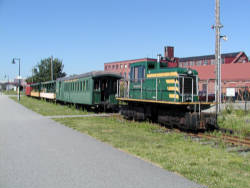
Portland Narrow Gauge Railway
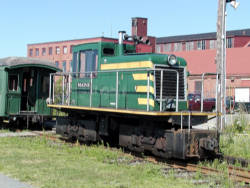
Portland Narrow Gauge Railway
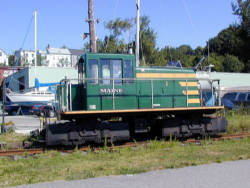
Portland Narrow Gauge Railway
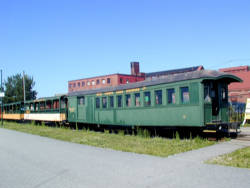
Portland Narrow Gauge Railway
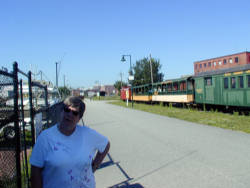
Portland Narrow Gauge Railway
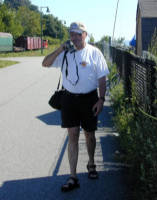
Portland Narrow Gauge Railway
Best Western
Travel to Bar Harbor, Maine
First stop was at the Maine Narrow Gauge Railway Co., that runs antique rolling stock pulled by steam and diesel locomotives along the Waterfront to the North of Portland center. It was closed but there was train and a diesel locomotive sitting in the yard.

Portland Narrow Gauge Railway |

Portland Narrow Gauge Railway |

Portland Narrow Gauge Railway |

Portland Narrow Gauge Railway |

Portland Narrow Gauge Railway |

Portland Narrow Gauge Railway |
Next stop before we actually headed North towards Bar Harbor, was Portland Observatory.
Quoting their WEB site:
It's not a lighthouse! (And it has nothing to do with astronomy.) The Portland Observatory (1807) is the only extant maritime signal station in the United States, and thus a unique architectural icon of maritime shipping and the "Golden Age of Sail." The Portland Observatory was added to the National Register of Historic Places in 1972, and has been recommended for National Historic Landmark status.
Sea captain-turned-entrepreneur, Lemuel Moody (1768-1846), ordered construction of this octagonal, 86 feet-high tower to serve as a communication station for Portland's bustling harbor. With his powerful telescope, Moody identified incoming vessels and then signaled merchants with coded signal flags. "Signalizing" allowed merchants ample time to reserve a berth on the wharves, and to hire a crew of stevedores before a vessel docked.
The Observatory was built at the eastern end of the Portland peninsula on Munjoy Hill, which was a cow pasture at the time. Moody built his home and other buildings near the tower. The complex was replete with banquet and dance halls as well as a bowling alley. From the time it opened in 1807, it was a tourist attraction.
The tower ceased its "signalizing" operations in 1923, and has been owned by the City of Portland since 1937. In 1936 the Portland Observatory was included in the Historic American Buildings Survey (HABS), and in 1939 the tower was a Works Progress Administration (WPA) project during the New Deal programs of the Great Depression.
In 1994 it was discovered that years of seeping moisture and an infestation of powder post beetles threatened the structure. Many architectural and historical preservation authorities came together to devise a plan for saving this historic building.
In 1997 Greater Portland Landmarks (GPL) chartered the Portland Observatory Restoration Trust (PORT) in order to raise funds for the ailing structure's ambitious restoration. More than six hundred donors contributed to PORT, including the City of Portland, corporations, charitable foundations, families, and individuals, as well as students from eleven local elementary schools who gave more than $5,000 through KidsPORT. PORT raised $1.28 million for the 1998-2000 restoration, which returned the building to its former glory.
>From the top of the Observatory, there are great views in all directions. Up and down the coast, out to sea and across Portland towards the airport in the distance.
Portland Observatory is now set in the middle of a residential area, next to a fire station. There used to be a streetcar line passing by. There is a fragment of track left in place as a keepsake.
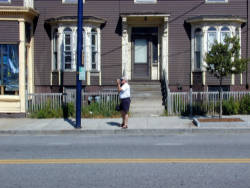
Mike near Portland Observatory |
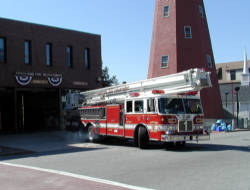
Fire Engine leaving Munjoy Hill Fire Station |
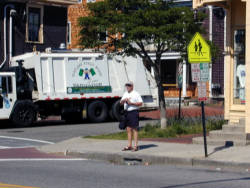
Portland Observatory |
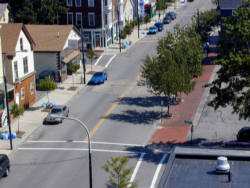
Congress Street |
The drive up to Bar Harbor was extremely hot .. Thank heavens for air conditioning. We stopped once for a light lunch and arrived at our hotel in mid afternoon.
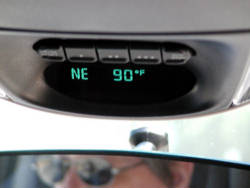
Hot day |
After checking in to our hotel, we stopped at the Arcadia National Park Visitor Center, where we saw a video on the history of the Park and bought a ticket to drive into the Park.
Though the affluent of the turn of the century came here to frolic, they had much to do with preserving the landscape that we know today. It was from this social strata that George B. Dorr came. He devoted 43 years of his life, energy, and family fortune to preserving the Acadian landscape. In 1916, Sieur de Monts National Monument was created with 6,000 acres of land donated by individual landowners. In 1919, it became Lafayette National Park, the first national park east of the Mississippi River. In 1929, the name was changed to Acadia National Park. Today, Acadia preserves about 40,000 acres of Atlantic coast shoreline, mixed hardwood and spruce/fir forest, mountains, and lakes, as well as several offshore islands.
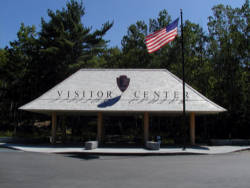
Visitor Center |
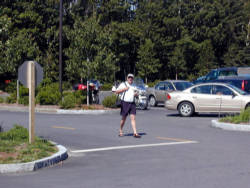
Mike at the Visitor Center |
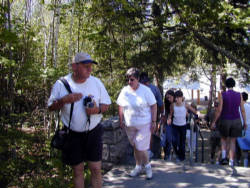
Mike & Sue at the Visitor Center |
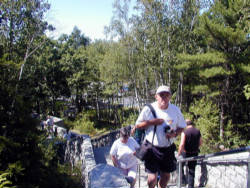
Mike & Sue at the Visitor Center |
And so to Bar Harbor. We had already booked a bus tour of the Acadia National Park, but we needed to make sure that we had somewhere to park out minivan.
Bar Harbor has long been a place of inspiration, relaxation, and outdoor activities. In the mid-1800ís artists of the Hudson Valley School, most notably Thomas Cole and Frederic Church, travelled to Mount Desert Island and to Bar Harbor in particular to paint seascapes and landscapes. The paintings then taken back to the cities of America were well received and the patrons of the art wanted to see those places depicted in the paintings for themselves. At first the "rusticators" as the first visitors were called, boarded with the locals. But as they wanted more and more amenities, it was clear that they needed different lodging choices.
During the 1850ís, the number of visitors began to increase. The numbers had increased so much that it was about this time that Church wondered why "some shrewd Bostonian" had not yet recognized the resort potential of Bar Harbor. So it was left to the initiative of the Bar Harborites to respond to the needs of its visitors. It was, in fact, the other side of the island at Southwest Harbor who first had the steamboat wharves and the hotels. But it was to Bar Harbor that the travellers wished to journey. It was Bar Harbor businessman Tobias Roberts who built the first hotel, Agamont House, in 1855 and the first wharf. It was Mr. Robertís foresight which was the key to Bar Harborís future resort development. While the white wooden structure may not have really deserved the name "hotel", it was intended to be a hotel and that is what is important. The first step had been taken. The hotel was crude, but to the early travellers it did not matter. Part of Bar Harborís charm at that time was its rusticity.
In the beginning, it was mostly artists, scholars, scientists, and writers who journeyed to Bar Harbor for inspiration and tranquility. With only a slight interruption by the Civil War, more and more visitors came to the rugged coastal community. Now and then even theater troupes stopped by and concerts were becoming more frequent. More and more local citizens ventured into the tourism business and more hotels were built. It wasnít until after the war that building really took off. In 1875 David Rodick, amidst some ridicule, expanded their small lodging facility by building the enormous Rodick House, Bar Harborís largest hotel at that time. The hotel could accommodate 275 guests. By 1870 there were sixteen hotels in Bar Harbor. At one point though, reservations for rooms had to be done two years in advance. So in 1881 Rodick decided to expand again. This time he built 400 rooms, with not one private bathroom, a huge dining room, and a 500 foot long, 25 foot wide porch running along the front and one side of the building. The dining room could serve 1000 guests, though reportedly not well. The main attraction to the hotel seemed to be the lobby, known as the Fish Pond and the porch where young ladies dallied "fishing" for husbands. The hotel era dominated the resort for about two decades. Ultimately, the "cottages" built by Americaís rich and famous took over the landscape.
All of the old hotels are gone either torn down or burned down by the great fire of 1947. Many of the "cottages" burned also, but some remain. Today many of the cottages are still private homes with many more converted to welcoming inns, guest homes, and bed & breakfasts.
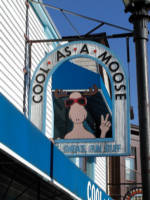
Cool as a Moose apparel outlet |
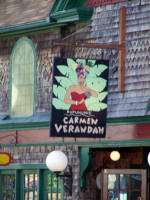
Carmen Verandah restaurant |

Dolls outside a B&B in Bar Harbor |
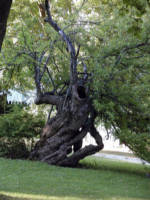
A gnarled old tree |
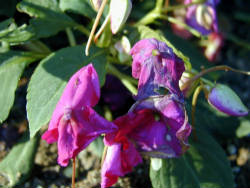
Flower |
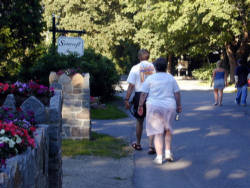
Mike and Sue walking through Bar Harbor |
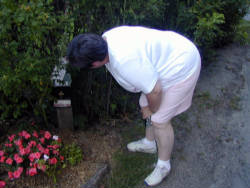
Sue admiring the flowers |
Bar Harbor and the National Park is a popular destination for Cruise Ships. While we were walking along the waterfront, the Norweigian Sea was moored just off-shore.
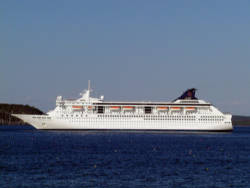
A cruise ship anchored off Bar Harbor |
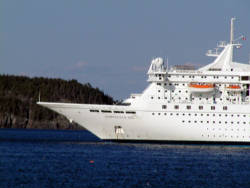
A cruise ship anchored off Bar Harbor |
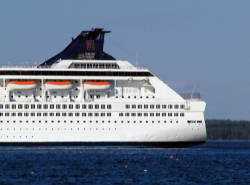
A cruise ship anchored off Bar Harbor |
In the late afternoon as the temperature became bearable, we enjoyed a pleasant walk along the waterfront from the Eastern end of Bar Harbor to the harbour itself, with views towards the strange islands off shore and the wide variety of boats.
We finished the day with dinner followed by a game of mini-golf just as the sun was going down (and the mosquitoes coming out to play).